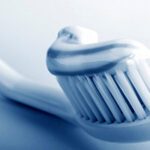Teething is a common topic among mothers because it may seem like baby is teething for months but tooth appears. Mothers have advice that works for some and not for others, but still we mothers want to know what is teething, how to spot the symptoms, and how to ease our child’s agony. This guide will teach even the most experienced mother about teething, the symptoms, and how to help baby get through this painful process.
What is Teething?
The question sounds silly, but many mothers want to know when, where, and how the teething process begins. A baby’s first set of teeth, known as the primary teeth are especially painful(although baby may not display signs of hurt) because they have the task of breaking through the gums.
Teething may start as early as three months or as late as twelve months(1). Around ten weeks, many mothers will see an excessive amount of drool leaving their baby’s mouth. No teeth will show yet, but this is the mouth’s way of preparing for upcoming teeth. It could be weeks or months before that first tooth makes an appearance within the gums(1).
The most common process for teething is the two bottom teeth cut first, then the two top teeth, followed by the surrounding teeth. It is important to remember that every baby is different and teeth may come in at different locations and at different times.
What Are the Symptoms?
There are many debates as to what symptoms indicate teething and which are coincidental. Let’s clear this up, shall we? Symptoms show up around three to five days before a teeth cuts through the gums, but it is possible that symptoms could last for weeks! According to the Mayo Clinic, the most common symptoms of teething are:
– excessive drooling
– swollen gums
– irritability
– chewing on everything
– white cap under the gums
These symptoms are the forerunners of symptoms, as they are directly linked to teething(all involve the mouth). On the other hand, there are a number of indirect symptoms that may or may not be linked to teething. For example, many mothers reported diarrhea and a low grade fever during the teething process, but pediatricians claim that there is no evidence linked to these symptoms and teething(2). So why the symptoms of a virus or cold? Professionals believe that teething may cause a lowered immune system which leaves the baby more susceptible to colds.
What Are Methods to Ease Baby’s Discomfort?
Some babies sail through teething with no sign of discomfort, while other babies will shriek in agony for days. It is hard to hear that cry of sadness and mothers want to do everything that they can to ease the pain. There are many great tools that mothers can use to help ease the pain of teething:
Breastfeeding
What better way to comfort that sad baby than with the warmth of the breast. Many babies enjoy breastfeeding for comfort during teething and mothers do not have to worry about messing up that feeding schedule because it will return to normal after the tooth has broken through the gums(2).
A Teething Ring
Ice cold teething rings will entertain the baby while reducing gum inflammation and numb the teething site. If baby does not want to chew on something hard, try a cold washcloth.
Apply Pressure
Clean your hands and apply soft, but firm pressure to the teething site. The pressure will ease the pain and bring mommy and baby closer together.
Try an over the counter remedy
If nothing is appeasing the pain, try a OTC remedy to relieve the pain from teething. Some suggestions are baby numbing gel or baby Tylenol. Never give the baby aspirin as it may cause a rare, but serious disease(2).
Teething is another milestone in the development of all babies. For some mothers it does not affect the lives of their little one, while others feel as though the whole schedule is ruined. Don’t give up on the teething angel, just yet because soon that little one will be eating solids and talking with smiles!
Sources:
1. WebMd- Teething and Your Baby
2. Mayo Clinic- Teething





